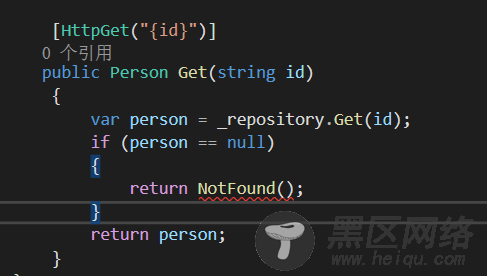在Asp.net Core之前所有的Action返回值都是ActionResult,Json(),File()等方法返回的都是ActionResult的子类。并且Core把MVC跟WebApi合并之后Action的返回值体系也有了很大的变化。
ActionResult类
ActionResult类是最常用的返回值类型。基本沿用了之前Asp.net MVC的那套东西,使用它大部分情况都没问题。比如用它来返回视图,返回json,返回文件等等。如果是异步则使用Task。
public class TestController : Controller { public ActionResult Index() { return View(); } public ActionResult MyFile() { return File(new byte[] { }, "image/jpg"); } public ActionResult MyJson() { return Json(new { name = "json" }); } public ActionResult Ok() { return Ok(); } }
IActionResult接口
ActionResult类实现了IActionResult接口所以能用ActionResult的地方都可以使用IActionResult来替换。同样异步的话使用Task包起来做为返回值。
public class ITestController : Controller { public IActionResult Index() { return View(); } public IActionResult MyFile() { return File(new byte[] { }, "image/jpg"); } public IActionResult MyJson() { return Json(new { name = "json" }); } public IActionResult HttpOk() { return Ok(); } public async Task<IActionResult> AsyncCall() { await Task.Delay(1000); return Content("ok"); } }
直接返回POCO类
Asp.net Core的Controller的Action可以把POCO类型(其实不一定是POCO类,可以是任意类型,但是使用的时候一般都返回viwemodel等POCO类)当做返回值,不一定非要是ActionResult或者IActionResult。Asp.net Core框架会帮我们自动序列化返回给前端,默认使用json序列化。同样异步的话使用Task包起来做为返回值。
public class Person { public string Name { get; set; } public string Sex { get; set; } } public class ITestController : Controller { public Person GetPerson() { return new Person { Name = "abc", Sex = "f" }; } public async Task<List<Person>> GetPersons() { await Task.Delay(1000); return new List<Person> { new Person { Name = "abc", Sex = "f" }, new Person { Name = "efg", Sex = "m" } }; } }
ActionResult< T >泛型类
当我们设计restful webapi系统的时候习惯使用POCO做为返回值。比如我们设计一个获取Person的api。通过 /person/001 url获取001号person。
[Route("[controller]")] public class PersonController : Controller { IPersonRepository _repository; PersonController(IPersonRepository repository) { _repository = repository; } [HttpGet("{id}")] public Person Get(string id) { return _repository.Get(id); } }
这个方法看起来好像没什么问题,但其实有个小问题。如果repository.Get方法没有根据id查找到数据,那么将会返回null。如果null做为Action的返回值,最后框架会转换为204的http status code。

204表示No Content 。做为restful api,204的语义在这里会有问题,这里比较适合的status code是404 NOT FOUND 。那么我们来改一下:
[HttpGet("{id}")] public Person Get(string id) { var person = _repository.Get(id); if (person == null) { Response.StatusCode = 404; } return person; }
现在如果查找不到person数据,则系统会返回404 Not Found 。

但是这看起来显然不够优雅,因为ControllerBase内置了NotFoundResult NotFound() 方法。这使用这个方法代码看起来更加清晰明了。继续改:
[HttpGet("{id}")] public Person Get(string id) { var person = _repository.Get(id); if (person == null) { return NotFound(); } return person; }
很不幸,这段代码VS会提示错误。因为返回值类型不一致。方法签名的返回值是Person,但是方法内部一会返回NotFoundResult,一会返回Person。

解决这个问题就该ActionResult< T >出场了。我们继续改一下:
[HttpGet("{id}")] public ActionResult<Person> Get(string id) { var person = _repository.Get(id); if (person == null) { return NotFound(); } return person; }
现在VS已经不会报错了,运行一下也可以正常工作。但仔细想想也很奇怪,为什么返回值类型改成了ActionResult< Person >就不报错了呢?明明返回值类型跟方法签名还是不一致啊?
深入ActionResult< T >
接上面的问题,让我们看一下ActionResult的内部:

看到这里就明白了原来ActionResult< T >里面内置了2个implicit operator方法。implicit operator用于声明隐式类型转换。
public static implicit operator ActionResult<TValue>(ActionResult result);
表示ActionResult类型可以转换为ActionResult< TValue >类型。
public static implicit operator ActionResult<TValue>(TValue value)
表示TValue类型可以转换为ActionResult< TValue >类型。
因为有了这2个方法,当ActionResult或者TValue类型往ActionResult< T >赋值的时候会进行一次自动的类型转换。所以VS这里不会报错。
总结
大部分时候Action的返回值可以使用ActionResult/IActionResult
设计restful api的时候可以直接使用POCO类作为返回值
如果要设计既支持POCO类返回值或者ActionResult类为返回值的action可以使用ActionResult< T >作为返回值
ActionResult< T >之所以能够支持两种类型的返回值类型,是因为使用了implicit operator内置了2个隐式转换的方法
